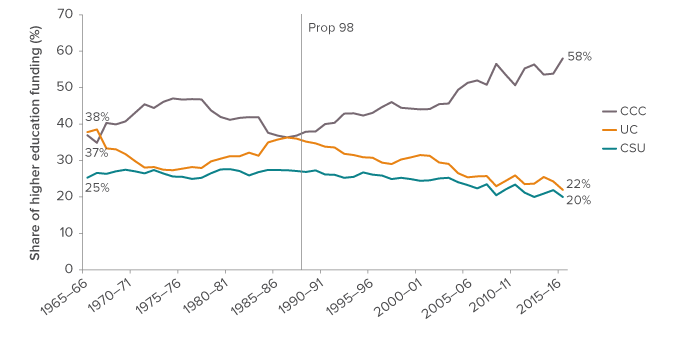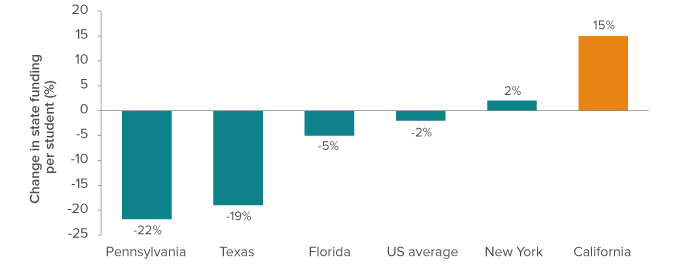-
- California spends 12% of its General Fund on higher education.
Higher education is the third largest General Fund expenditure, after K–12 education and health and human services. The majority ($12.3 billion) of this funding is divided among the three public higher education systems: the University of California (UC), California State University (CSU), and the California Community Colleges (CCC). - State higher education funding has declined as a share of the budget over the past four decades.
Higher education spending accounted for 18% of the state budget in 1976–77, but by 2016–17 higher education funding had fallen to 12% of the budget. These funding cuts have been felt most strongly at the University of California, where funding per full-time-equivalent student fell from slightly more than $23,000 to about $8,000. CSU funding per student has also fallen by about 25% since 1976–77 from slightly more than $11,000 per student to slightly less than $9,000. - In response to funding cuts, UC and CSU increased tuition dramatically.
Over the past 20 years, tuition has tripled at both UC and CSU. However, the state financial aid system (Cal Grants), combined with federal and institutional aid, pays the tuition of more than half of the 674,015 full-time-equivalent students in 2016–17. A majority (55%) of UC students and about half (51%) of CSU students pay no tuition. Though both systems have kept tuition flat during the recovery from the Great Recession, each system has proposed to raise tuition in 2017–18—the first increase since 2010. - Proposition 98 has shifted state higher education funding toward the community colleges.
Proposition 98 (enacted in 1988) requires that a minimum share of the state budget be allocated to K–14 education; community colleges usually receive around 11% of this funding. Before the passage of Proposition 98, each higher education system received a roughly equal percentage of state funding. By 2015–16, the UC and CSU systems were sharing about 40% of the state funding, while 60% was allocated to the community colleges.
- California spends 12% of its General Fund on higher education.
Proposition 98 has increased the share of community college funding

SOURCES: California Postsecondary Education Commission. Years 2011–12 to 2015–16 derived from budgetary data provided by Department of Finance.
NOTE: General Fund expenditures in this chart do not include federal American Recovery and Reinvestment Act funds that were used to replace state higher education funding from 2008 to 2011. General Fund expenditures for other higher education purposes, including Cal Grants, are also excluded.
-
- Community college funding is at an all-time high.
Community college funding has increased significantly since the Great Recession. In 2011–12, per student funding was less than $5,000; now it is approaching $7,000. It is still lower than per student funding in the UC, CSU, and K–12 systems. - California has reinvested more heavily in higher education than the rest of the nation.
Between 2010, the beginning of the economic recovery, and 2015–16, California increased per student funding by 15%. Average investment nationwide increased 2% during this period, and some large states—such as Pennsylvania and Texas—cut funding by about 20%.
- Community college funding is at an all-time high.
Compared to other populous states, California has significantly reinvested in higher education

SOURCE: State Higher Education Executive Officers (SHEEO), State Higher Education Finance: FY 2015.
NOTE: Illinois has increased investment by 32.5% since 2010, but most of that increase has been allocated to its historically underfunded pension program for higher education employees.
Topics
Finance Higher Education

